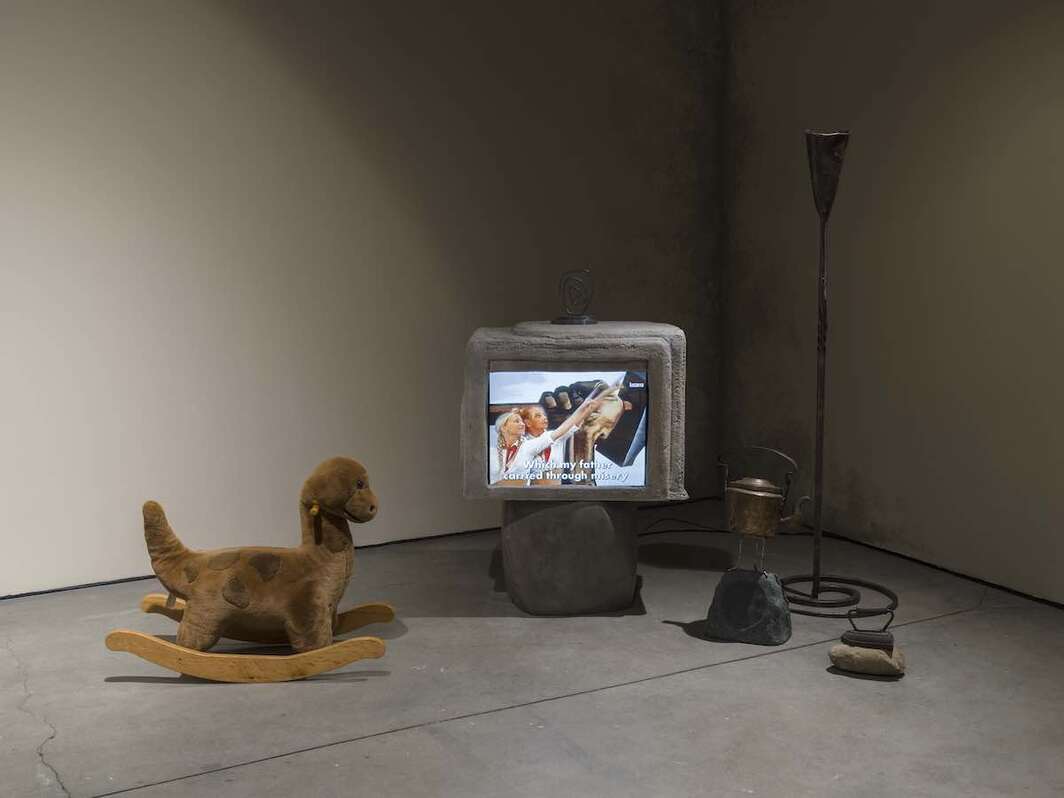The conspiracy in your living room – Artforum

Growing up in a newly reunified Germany, Henrike Naumann witnessed widespread transformations in visual culture, from popular television programming to the seating from which that programming was consumed. Working with furniture and video, the Zwickau-born, Berlin-based artist considers how seemingly innocuous aesthetic sensibilities align with and promulgate a host of political ideologies. Her first US solo exhibition, “Re-Education,” on view from September 22 to February 27 at SculptureCenter in New York, parses parallels between reactionary movements in the United States and Germany as it takes a critical eye to fabulation by design.
I STARTED OUT doing stage and costume design for theater; later, I became a scenographer for film and television in studios that dated back to the former German Democratic Republic. Back then, I thought a lot about how a text might be translated into a space, which is akin to my process now: I convert reading and research into a set in which the visitor implicitly performs. In 2011, it was discovered that the National Socialist Underground, a white supremacist terror cell, was living undercover in my hometown of Zwickau while murdering immigrants throughout Germany. I was visiting my grandmother when NSU members burned down their hideout just a mile away. These events prompted me to repurpose my skill set to explore the ways in which histories of political change, and political violence, are documented and discussed. For the past decade, I have approached domestic space through a documentary format, working with furniture and design aesthetics to address the social and cultural transformation that accompanied the transition from socialism to capitalism in East Germany. In recent years, I’ve expanded my practice to consider the Cold War more globally.
With “Re-Education,” I wanted to look at the United States from a German perspective, as well as through mediated television images, because that’s what I can speak to. After German reunification, mass-produced copies of postmodern designs flooded East German homes; people got rid of their socialist furniture and bought these pyramidal cabinets, a political-aesthetic shift that shocked and excited me as a child. At that point, I was also exposed to American media culture as it filtered in secondhand from West Germany. The Flintstones was the first cartoon show that taught me about America in the ’90s, though it was actually produced in the early ’60s—television’s Stone Age—in the context of the Cold War and the Cuban Missile Crisis. The show, which some believe takes place in a postapocalyptic future, projects the American family unit and American capitalism onto prehistory: no interruption, no Indigenous cultures, just the American way of life perpetually enabled by the exploitation of dinosaur labor. I want viewers to critically consider the things they’ve grown up with and interrogate aesthetics that might seem funny, weird, or unserious, but that can also be deeply dangerous.

The events of January 6 made me realize that the language I had developed to speak about far-right radicalization and the fragility of democracy in Germany was applicable to an American context. In 2017, at the Kronprinzenpalais where the German Reunification Treaty was signed in 1990, I presented work about the Reichsbürgerbewegung, a revisionist, racist movement on the rise that is predicated on the conspiracy theory that the Federal Republic of Germany is illegitimate: The Reichsbürgers believe that, because a peace treaty was not negotiated after World War II, the German Reich still exists, and perceive themselves as people under threat in an occupied country. Reactionary movements have intriguing aesthetic parallels; for example, a National People’s Army helmet drilled with horns, which I based on a far-right social media post from my hometown, inserts this contradictory East German Viking identity construction at the site of a historical break—and is mirrored in the headgear of the spear-carrying Capitol rioter known as the QAnon Shaman.
On January 6, furniture was used as a weapon to break into the Capitol, but it was also the means by which congresspeople erected barricades to protect themselves. I reached out to the Smithsonian to see if furniture from the event had been preserved, but it seems it’s not considered a historical document in the same way that banners, flags, or destroyed artworks are. At SculptureCenter, I built a monument to the pivotal role that Federal-style furniture, a quintessentially American idiom adapted from neoclassicism, played in this political event. I stacked pieces of furniture and armed them with rustic weapons, almost turning these objects into rioters themselves. On the wall on either side of the domed installation, I emblazoned the words “very fine people on both sides,” Donald Trump’s assertion about white supremacist rallies and counterprotests in Charlottesville—which anticipated his claims that it was really Antifa that stormed the Capitol.
I’m interested in the impact that “horseshoe theory,” which is a fixture in German media, has had on political discourse in the US. The horseshoe metaphor was first used in 1930s Germany to convey an idea of the political spectrum in which political extremes bend toward each other in a horseshoe shape, and a “center” balances them out. In the context of where I grew up in Germany, the state’s focus on fighting extremism on the left enabled right-wing terrorism—but the horseshoe form invariably equalizes the far left and the far right, regardless of the degree of violence used or how far society drifts toward the latter. What have we normalized as “the center” now?
— As told to Cassie Packard
This article has been archived for your research. Find the original article here.


